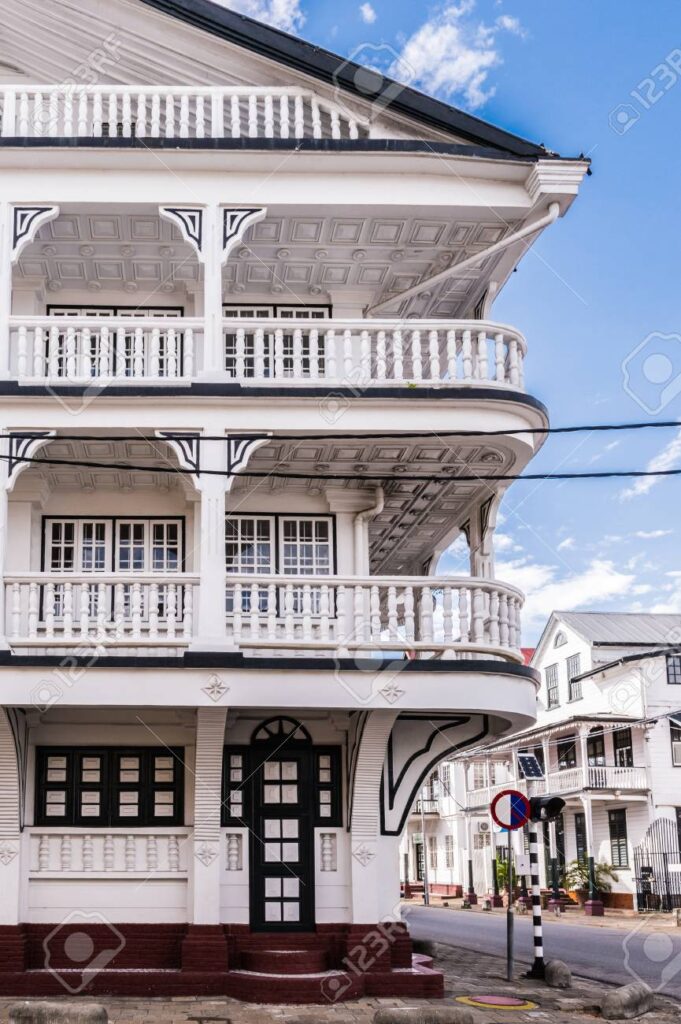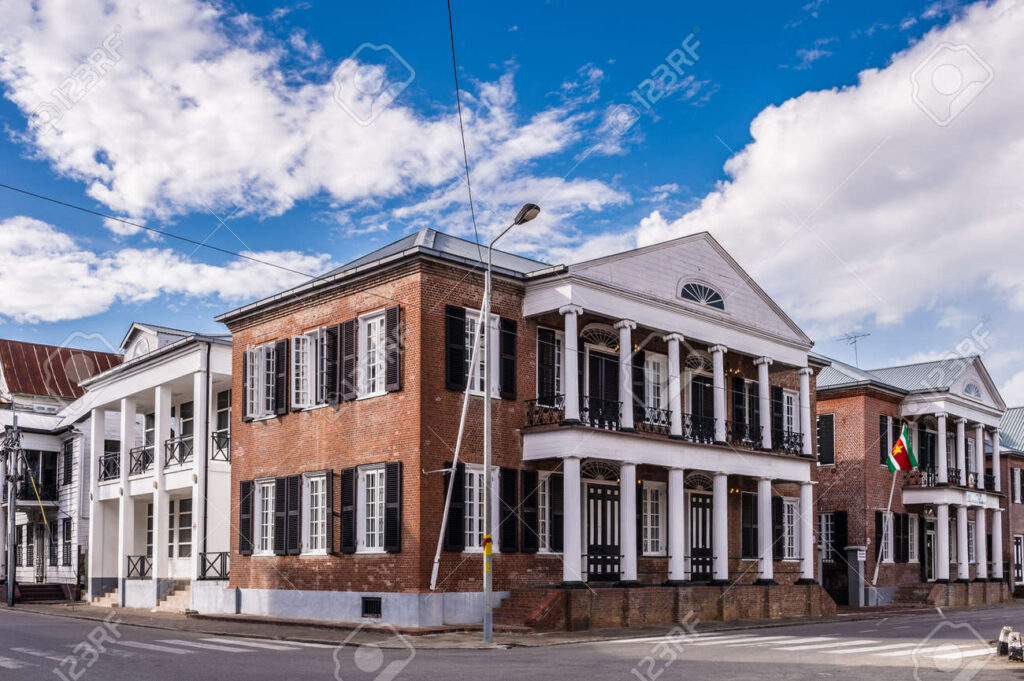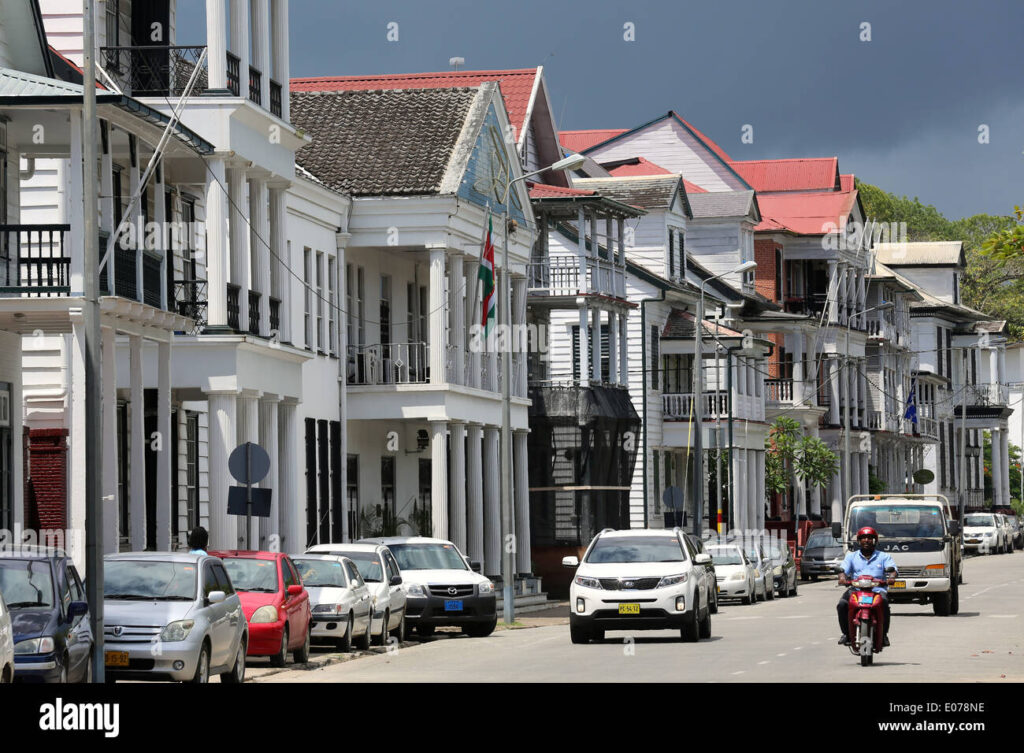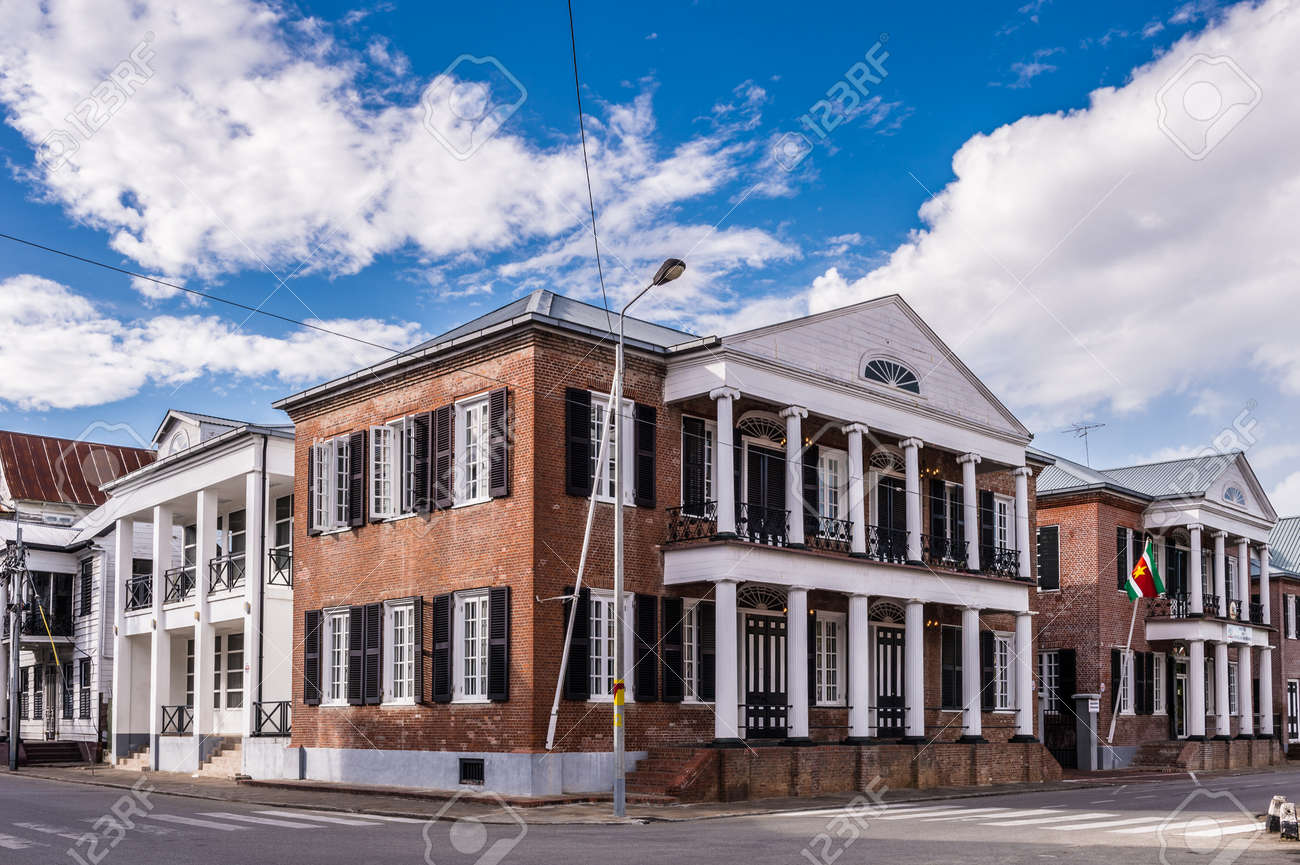Have you ever walked down a street that seemed to transport you back in time? A street that oozes with historic charm and tells stories of bygone eras? Well, if you find yourself in Paramaribo, Suriname, you’re in luck because Waterkant Street is just the place for you.
Waterkant Street, located along the Suriname River, is a treasure trove of history and culture. As you stroll along this picturesque street, you’ll be greeted by the stunning Dutch colonial architecture that lines both sides. The vibrant colors and intricate designs of these buildings are a testament to the city’s rich cultural heritage.
But it’s not just the architecture that will captivate you. Waterkant Street is also home to several historical landmarks and attractions. From the iconic Presidential Palace to the imposing Fort Zeelandia, there is no shortage of things to see and learn about. You’ll discover the fascinating history of Suriname and how it has shaped the city into what it is today. There are also charming cafes and restaurants where you can grab a bite to eat and soak in the atmosphere.
In this article, we will delve deeper into the historic charm of Waterkant Street in Paramaribo, exploring its highlights and uncovering the hidden gems that await you. So, if you’re ready to take a trip through time and immerse yourself in the beauty of Suriname’s capital city, keep reading to learn more.

Overview
Waterkant Street in Paramaribo, Suriname is a place where history comes alive. As you stroll along this picturesque street, you will be captivated by its colonial architecture, rich cultural diversity, and numerous historical landmarks. From the iconic Fort Zeelandia to the vibrant Paramaribo Carnival, there is something for everyone to enjoy on Waterkant Street. Join us as we delve into the fascinating world of this historic gem, uncovering its hidden treasures and exploring its timeless beauty.
Introduction to Waterkant Street in Paramaribo
Waterkant Street, also known as Waterfront Street, is a bustling thoroughfare that runs parallel to the Suriname River in the heart of Paramaribo, the capital city of Suriname. With its stunning views of the river and its lively atmosphere, Waterkant Street has long been a favorite spot for locals and tourists alike. The street is lined with beautifully preserved colonial buildings, which provide a glimpse into Suriname’s rich history. As you take a leisurely stroll along this vibrant street, you will find yourself immersed in a world of historical charm and architectural splendor.
Significance of Waterkant Street in Paramaribo
Waterkant Street is not just a collection of buildings; it is a testament to Paramaribo’s colonial past and its cultural heritage. The street played a crucial role in the city’s development during the Dutch colonial period, and many of its architectural features reflect this influence. From its traditional Dutch-style facades to its unique blend of European and Surinamese architectural elements, Waterkant Street stands as a symbol of the city’s diverse history and cultural identity.
Colonial Architecture
One of the most striking features of Waterkant Street is its colonial architecture. The buildings along the street showcase a blend of Dutch, British, and French architectural styles, reflecting the various colonial influences that shaped Suriname’s history. These buildings are characterized by their distinctive gabled roofs, ornate balconies, and colorful facades. As you walk along Waterkant Street, you can’t help but be enchanted by the timeless beauty and elegance of these architectural masterpieces.
Design and architectural features of buildings on Waterkant Street
The buildings on Waterkant Street are not only visually stunning but also hold great historical and architectural significance. Their design and features are a testament to the craftsmanship of the colonial era. Many of the buildings have intricate wooden detailing, such as carved wooden shutters and decorative cornices. The use of vibrant colors, such as bright blues and yellows, adds to the street’s vibrant atmosphere. Each building tells a unique story, and exploring their architectural nuances is like stepping back in time.
Influence of Dutch colonialism on architecture
Dutch colonialism left an indelible mark on Waterkant Street’s architecture. The Dutch were the first European colonizers in Suriname, and their influence can be seen in the design and layout of the buildings. The streetscape is reminiscent of Dutch canal cities, with the buildings situated close to the water and connected by small alleys and bridges. The Dutch also introduced the use of brick and timber construction techniques, which are still evident in the buildings along Waterkant Street. This blend of Dutch and Surinamese architectural styles gives the street its unique character and charm.
Historical Landmarks
Waterkant Street is dotted with numerous historical landmarks that offer a glimpse into Suriname’s past. These landmarks are not only architectural marvels but also hold great cultural and historical significance. Three of the most notable landmarks on Waterkant Street are Fort Zeelandia, the Presidential Palace, and the Saint Peter and Paul Cathedral.

Fort Zeelandia: A symbol of Dutch influence
Fort Zeelandia is a fortress that dates back to the 17th century and stands as a symbol of Suriname’s Dutch colonial past. Originally built to protect the city from invasions, the fort has also served as a government building, prison, and now a museum. It offers a fascinating insight into Suriname’s history, with exhibits showcasing the country’s colonial era and the struggles for independence. The fort’s commanding position along the Suriname River provides breathtaking views of the water and surrounding area, making it a must-visit landmark on Waterkant Street.
Presidential Palace: An iconic landmark
Located at the eastern end of Waterkant Street, the Presidential Palace is an iconic landmark that embodies the power and grandeur of Suriname’s government. The neoclassical-style building, with its imposing columns and grand entrance, is an architectural masterpiece. While the palace is not open to the public, visitors can admire its exterior and marvel at its architectural beauty. The surrounding gardens, adorned with statues and manicured lawns, provide a picturesque setting for a leisurely stroll.
Saint Peter and Paul Cathedral: A masterpiece of Gothic architecture
The Saint Peter and Paul Cathedral is a breathtaking masterpiece that dominates the skyline of Waterkant Street. Built in the Gothic architectural style, the cathedral is a symphony of soaring arches, intricate stained glass windows, and ornate stone carvings. Its towering spires and majestic facade make it a true architectural gem. The cathedral not only serves as a place of worship but also hosts cultural events and concerts, bringing the community together in celebration of Surinamese heritage.
Cultural Diversity
Suriname is often referred to as the “melting pot of cultures,” and nowhere is this more evident than on Waterkant Street. The street’s rich cultural diversity is reflected in its architecture, cuisine, and various historical events that take place throughout the year.
Influence of diverse cultures on Waterkant Street
Waterkant Street bears the legacy of Suriname’s diverse cultural heritage. The buildings along the street showcase a blend of architectural styles influenced by Dutch, British, French, and African cultures. Each culture has left its mark on the street, creating a unique tapestry of architectural wonders. From the ornate wooden facades reminiscent of Dutch colonial buildings to the vibrant colors inspired by African traditions, Waterkant Street is a celebration of Suriname’s cultural diversity.
Historical events showcasing cultural diversity
Waterkant Street plays host to numerous historical events that celebrate Suriname’s cultural diversity. One such event is Keti Koti, which commemorates the abolition of slavery in Suriname. Held every year on July 1st, Keti Koti is a vibrant celebration of freedom, featuring live music, traditional dances, and a colorful parade along Waterkant Street. The Paramaribo Carnival is another highlight of the cultural calendar, with its lively street parties, dazzling costumes, and infectious music. These events offer a unique opportunity to immerse yourself in Surinamese culture and connect with the vibrant spirit of Waterkant Street.
Museums and Art Galleries
Waterkant Street is home to several museums and art galleries that offer a deeper understanding of Suriname’s history, art, and cultural heritage. From the Suriname Museum to the Fort Zeelandia Museum, these institutions provide a wealth of knowledge and a chance to explore Suriname’s rich cultural tapestry.

Suriname Museum: Preserving the country’s heritage
The Suriname Museum is a treasure trove of artifacts and exhibits that showcase the country’s history, culture, and natural heritage. Housed in a beautifully restored colonial building, the museum takes visitors on a journey through Suriname’s past, from the indigenous cultures that first inhabited the land to the impact of the colonial era. The museum’s collection includes archaeological finds, traditional crafts, and historical documents that shed light on Suriname’s diverse heritage.
Maritime Museum: Showcasing Paramaribo’s maritime history
Located near Waterkant Street, the Maritime Museum is dedicated to preserving and showcasing the maritime history of Paramaribo and Suriname. The museum provides a fascinating insight into the city’s seafaring past, with exhibits on shipbuilding, navigation, and the trade routes that connected Suriname to the rest of the world. Visitors can explore historic ship models, maritime artifacts, and learn about the challenges and triumphs of Suriname’s seafaring history.
Fort Zeelandia Museum: Uncovering the past
The Fort Zeelandia Museum, located within the historic fort itself, is a must-visit destination for history enthusiasts. The museum offers a comprehensive overview of Suriname’s colonial history, highlighting the struggles for independence and the impact of the Dutch colonial period. From the dark chapters of slavery and the slave trade to the fight for freedom, the museum provides a thought-provoking and educational experience. The artifacts and exhibits offer a glimpse into Suriname’s complex past, allowing visitors to understand the forces that have shaped the country and its people.
Prominent Historical Figures
Waterkant Street has been the birthplace and home of many prominent historical figures who have made significant contributions to Suriname’s art, culture, and struggle for independence. Two such figures are Nola Hatterman and Anton de Kom.
Nola Hatterman: Celebrating Surinamese art and culture
Nola Hatterman was a pioneering artist and educator who championed the importance of art in preserving and celebrating Surinamese culture. Born and raised on Waterkant Street, Hatterman played a significant role in establishing Suriname’s first art school and encouraging young artists to explore their heritage through their artwork. Her paintings often depicted scenes from everyday life in Suriname, capturing the essence of the country’s diverse cultural landscape. Hatterman’s legacy continues to inspire artists and art lovers alike, reminding us of the importance of preserving and celebrating Surinamese art and culture.
Anton de Kom: Champion of Surinamese independence
Anton de Kom was a prominent Surinamese writer, anti-colonialist, and advocate for Surinamese independence. Born and raised near Waterkant Street, de Kom played a vital role in raising awareness about the plight of the Surinamese people under Dutch colonial rule. His book, “We Slaves of Suriname,” shed light on the brutal conditions of slavery and the struggles faced by the descendants of enslaved Africans in Suriname. De Kom’s work was instrumental in shaping the discourse on Surinamese identity and fostering a sense of national pride. His courage and determination continue to inspire Surinamese people to this day.
Local Cuisine and Markets
Waterkant Street is a food lover’s paradise, offering a diverse array of culinary delights that reflect the country’s multicultural heritage. From street food stalls to vibrant markets, the street is a haven for those seeking to indulge in Surinamese cuisine.

Exploring Waterkant Street’s culinary delights
Waterkant Street is renowned for its street food vendors, where you can sample a variety of Surinamese delicacies. From the spicy flavors of roti and masala to the mouthwatering freshness of tropical fruits, the street offers a taste of Suriname’s culinary delights. Don’t miss the opportunity to try traditional Surinamese dishes such as pom, a flavorful casserole made with chicken or salted meat, and bakabana, a sweet and crispy treat made with ripe plantains. As you savor these authentic flavors, you’ll get a true taste of the cultural fusion that defines Surinamese cuisine.
Paramaribo Central Market: A vibrant hub of local culture
Just a short walk from Waterkant Street, the Paramaribo Central Market is a bustling hub of activity and a feast for the senses. Here, you can immerse yourself in the vibrant energy of Surinamese culture, as locals and vendors go about their daily routines. The market is a treasure trove of fresh produce, aromatic spices, and handicrafts, making it the perfect place to shop for souvenirs or sample local delicacies. From Suriname’s famous bananas and cassava to exotic fruits and freshly caught fish, the market offers a kaleidoscope of colors and flavors that will leave you craving for more.
Carnival and Festivals
Suriname is a country known for its vibrant festivals and rich cultural traditions, and Waterkant Street is at the heart of these celebrations. Two of the most iconic festivals on the street are Keti Koti and the Paramaribo Carnival.
Keti Koti: Commemorating the abolition of slavery
Keti Koti, meaning “Breaking the Chains,” is an annual festival that commemorates the abolition of slavery in Suriname. Held on July 1st, the festival brings together people from all walks of life to celebrate freedom, unity, and cultural heritage. The highlight of the festival is a colorful parade that winds its way along Waterkant Street, filled with music, dance, and exuberant displays of Surinamese pride. Keti Koti is a powerful reminder of the resilience and strength of the Surinamese people, as well as a celebration of their cultural diversity.
Paramaribo Carnival: A lively celebration of Surinamese culture
The Paramaribo Carnival is one of the liveliest and most anticipated events on the Surinamese calendar. Taking place over several days, the carnival is a riot of music, dance, and elaborate costumes. Waterkant Street comes alive with vibrant parades, pulsating rhythms, and infectious energy. Thousands of locals and tourists flock to the street to witness the spectacle and join in the revelry. The carnival is a celebration of Surinamese culture, showcasing the country’s diverse traditions and heritage. Whether you choose to watch the parades or join in the festivities, the Paramaribo Carnival is an experience not to be missed.
Waterfront Activities
Waterkant Street’s proximity to the Suriname River offers a wide range of waterfront activities for visitors to enjoy. Whether you prefer a tranquil boat tour or a leisurely stroll along the Waterkant Promenade, there is something for everyone to indulge in.
Boat tours along the Suriname River
A boat tour along the Suriname River is a fantastic way to explore the city from a different perspective and soak in the natural beauty that surrounds Waterkant Street. From the comfort of a riverboat, you can admire stunning views of Paramaribo’s skyline, watch the sun set over the water, and spot wildlife along the riverbanks. Boat tours also provide an opportunity to learn about the river’s historical and ecological significance, adding a layer of depth to your exploration of Waterkant Street.

Relaxing at Waterkant Promenade
Waterkant Promenade, located just steps away from Waterkant Street, is the perfect place to unwind and take in the tranquil atmosphere of the Suriname River. The promenade is lined with benches and shaded areas, offering a peaceful retreat from the hustle and bustle of the city. Sit back, relax, and watch the river flow as you reflect on the rich history and cultural heritage of Waterkant Street. Don’t forget to bring your camera, as the promenade offers stunning views of the river and the iconic skyline of Paramaribo.
Nightlife and Entertainment
As the sun sets over Waterkant Street, the area comes alive with a vibrant nightlife scene. From bars and clubs to live music performances, there is no shortage of entertainment options for those looking to let loose and have some fun.
Nightclubs and bars along Waterkant Street
Waterkant Street is home to a variety of nightclubs and bars that cater to different tastes and preferences. Whether you’re in the mood for dancing to Caribbean beats, enjoying live music, or simply sipping a cocktail while taking in the energetic atmosphere, there is a venue to suit every mood. From trendy rooftop bars with panoramic views to cozy, laid-back lounges, the street offers a range of options for a memorable night out.
Live music performances and cultural shows
Music is an integral part of Surinamese culture, and Waterkant Street is the perfect place to experience the country’s vibrant music scene. Many bars and clubs along the street host live music performances, ranging from traditional Surinamese music to jazz, reggae, and contemporary pop. Additionally, cultural shows showcasing Surinamese dance and music are often held in venues along Waterkant Street, providing an opportunity to immerse yourself in the rich artistic traditions of the country.
Historical Preservation Efforts
Preserving Waterkant Street’s rich architectural heritage is of utmost importance to the Surinamese people. Various conservation organizations and restoration projects are working tirelessly to protect and restore the historic buildings along the street.
Conservation organizations preserving Waterkant Street’s heritage
Several organizations in Suriname are dedicated to preserving Waterkant Street’s architectural heritage and promoting its cultural significance. The Suriname Heritage Foundation, for example, is actively involved in the restoration and maintenance of historic buildings, ensuring that they retain their authenticity and charm. These organizations work closely with local communities, government agencies, and international partners to safeguard Waterkant Street’s historic charm for future generations to enjoy.
Restoration projects and architectural conservation
Restoration projects are underway to revitalize and preserve the architectural gems of Waterkant Street. These projects aim to restore the buildings to their former glory, while also ensuring that they meet modern safety and accessibility standards. Through careful renovation and preservation techniques, the unique character and heritage of the street are preserved, allowing visitors to experience its historic charm for years to come.
Urban Development
Paramaribo is undergoing urban development initiatives to enhance the livability and preservation of Waterkant Street. These initiatives focus on improving infrastructure, enhancing public spaces, and promoting sustainable urban planning principles.
Infrastructure improvements and modernization
To accommodate the growing number of visitors and enhance the experience along Waterkant Street, infrastructure improvements are being made. These include upgrading pedestrian walkways, installing proper lighting, and improving accessibility. The aim is to create a safe and enjoyable environment for both locals and tourists, while preserving the street’s unique architectural heritage.
Urban planning initiatives for Waterkant Street
Paramaribo’s urban planning initiatives for Waterkant Street focus on sustainable development and preserving the street’s cultural heritage. These initiatives aim to strike a balance between modernization and the preservation of traditional architecture, ensuring that Waterkant Street remains a vibrant, thriving part of Paramaribo’s urban fabric. By integrating green spaces, pedestrian-friendly infrastructure, and sustainable design principles, the city is creating a harmonious environment that respects its past while embracing its future.
Tourism and Visit Recommendations
If you’re planning a trip to Paramaribo, a visit to Waterkant Street is a must. Here are some tips and recommendations to make the most of your time exploring this historic gem:
Tips for exploring Waterkant Street
- Wear comfortable walking shoes as you’ll be doing a lot of walking along the street.
- Bring a hat, sunscreen, and plenty of water, especially if you plan to explore during the day when it can get quite hot.
- Take your time and soak in the ambiance of Waterkant Street. Stop at the various cafes, restaurants, and shops along the way to get a true sense of the street’s vibrancy.
- Engage with the locals and learn about their experiences and stories. Surinamese people are known for their warmth and hospitality, and they are always eager to share their culture and history.
Recommended attractions and activities
- Start your exploration of Waterkant Street at Fort Zeelandia, where you can learn about Suriname’s colonial history and enjoy stunning views of the river.
- Visit the Suriname Museum to get a deeper understanding of the country’s cultural heritage and explore its diverse exhibits.
- Take a leisurely stroll along Waterkant Promenade and enjoy the tranquility of the Suriname River.
- Indulge in the flavors of Surinamese cuisine by sampling the street food along Waterkant Street or visiting the Paramaribo Central Market.
- Immerse yourself in Surinamese culture by attending one of the cultural events or festivals that take place along Waterkant Street.
- End your day by exploring the lively nightlife scene, with its bars, clubs, and live music performances.
Conclusion
Waterkant Street in Paramaribo truly encapsulates the historic charm and cultural richness of Suriname. From its colonial architecture to its vibrant festivals and cultural diversity, the street offers a captivating journey through time. As you wander along its picturesque, lively streets, you’ll be transported to a world where past and present coexist harmoniously. Waterkant Street is not just a place to visit; it is an experience that will leave an indelible mark on your heart and a profound appreciation for Suriname’s unique heritage. So, embrace the charm of Waterkant Street, immerse yourself in its timeless beauty, and let the spirit of Paramaribo envelop you.
